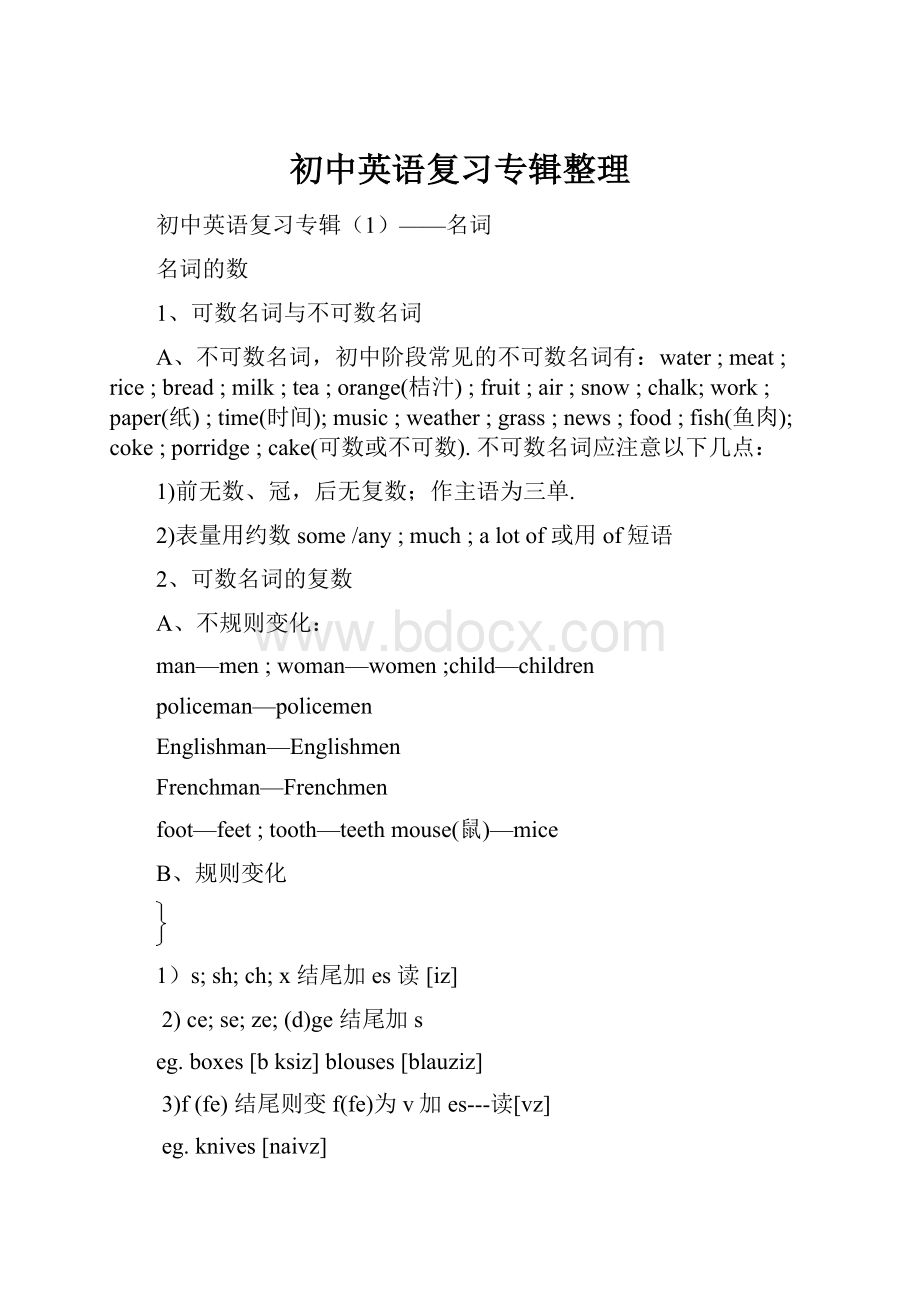 初中英语复习专辑整理.docx
初中英语复习专辑整理.docx
- 文档编号:27359396
- 上传时间:2023-06-29
- 格式:DOCX
- 页数:42
- 大小:200.60KB
初中英语复习专辑整理.docx
《初中英语复习专辑整理.docx》由会员分享,可在线阅读,更多相关《初中英语复习专辑整理.docx(42页珍藏版)》请在冰豆网上搜索。

初中英语复习专辑整理
初中英语复习专辑
(1)——名词
名词的数
1、可数名词与不可数名词
A、不可数名词,初中阶段常见的不可数名词有:
water;meat;rice;bread;milk;tea;orange(桔汁);fruit;air;snow;chalk;work;paper(纸);time(时间);music;weather;grass;news;food;fish(鱼肉);coke;porridge;cake(可数或不可数).不可数名词应注意以下几点:
1)前无数、冠,后无复数;作主语为三单.
2)表量用约数some/any;much;alotof或用of短语
2、可数名词的复数
A、不规则变化:
man—men;woman—women;child—children
policeman—policemen
Englishman—Englishmen
Frenchman—Frenchmen
foot—feet;tooth—teethmouse(鼠)—mice
B、规则变化
1)s;sh;ch;x结尾加es读[iz]
2)ce;se;ze;(d)ge结尾加s
eg.boxes[bksiz]blouses[blauziz]
3)f(fe)结尾则变f(fe)为v加es---读[vz]
eg.knives[naivz]
4)“辅+y”结尾变y为i加es
5)一般加s
3、名词所有格:
名词’s(意思是“……的”)
A.有生命的名词所有格,一般在后加“’s”但注意:
1)表两者共有则在后者加“’s”
LucyandLily’sfather露西和莉莉的父亲
Lucy’sandLily’sfathers露西的父亲和莉莉的父亲.
2)以s结尾的词只加“’”
eg.1)theboys’books2)James’father
3)无生命的名词所有格用of来引导
eg.thelegofthedesk
4)双重所有格:
afriendofmyfather’s
afriendofmine(√)afriendofmy(×)
初中英语复习专辑
(2)——冠词
1、不定冠词a,an
2、定冠词the
1)特指某人/某物
Thebookonthedeskismine.
2)世上独一无二的事物前
thesun,themoon,theearth,thesky
3)形、副最高级及序数词前
Thethirdboyisthetallestofall.
(但当这些词前已有其他限定词,如物主代词、所有格、指示代词时,则不能再用the)
HeismyfirstEnglishteacher.
4)the+姓的复数表示“某家人”或“某夫妇”。
theGreens格林一家/格林夫妇
3、不用冠词的几种情况:
1)在星期、月份、季节前不用冠词
2)学科名词前
3)球类运动及早、中、晚三餐名词前(但:
①当三餐名词前有修饰词时,则要加适当的冠词.②表乐曲演奏的名词前应加the)
1)Hewenttoschoolafterhehadaquickbreakfast.
2)playtheviolin/piano
初中英语专辑(3)——代词
(一)指示代词:
this,that,these,those.this,that一般与可数名词的单数连用,而不与不可数名词连用(但that可单独指代不可数名词)。
(二)人称代词、物主代词和反身代词
1)人称代词:
主格、宾格(作主语为主格,作宾语为宾格;介+宾格)
2)物主代词:
形容词性物主代词和名词性物主代词。
3)反身代词:
某某自己;亲自
单数
复数
yourself
yourselves
myself
ourselves
himself
themselves
herself
itself
反身代词的常见搭配:
1.enjoyoneself玩得高兴;过得愉快
2.hurtoneself伤着自己
3.teachoneself=learn…byoneself自学
4.(all)byoneself(完全)独立地
5.helponeselfto请自便;随便吃…
6.lookafteroneself自理;照顾自己
7.leaveonebyoneself把…单独留下
8.loseoneselfin陶醉于…;沉浸于…
(三)不定代词
1)some与any
一般情况下,some用于肯定句,any用于否定句、疑问句(但表邀请、建议的问句中可用some—此类句型常以could,would开头)
2)many+可数=alotof:
许多
much+不可数
(但alotof不能用于否定句)
3)few,afew;little,alittle
表否定
表肯定
可数
few(几乎没有)
afew(几个;一些)
不可数
little(几乎没有)
alittle(一点儿少许)
①.Thestoryiseasytoread.Thereare____newwordsinit.[few]
②.Hurryup!
Thereis_____timeleft.[little]
4)everyone/anyone不加of
noone不加of
noneof
()____ofuswantstoreadthebook.[B]
A.EveryoneB.Everyone
C.NobodyD.Noone
5)other,another,others
单数
复数
泛指
another
三者以上的另一个
定语
主语、宾语
other
some…others
特指
one…theother
一个…另一个
theothers=theother+复名(另外的人或物)
①.Westudy_____subjectsbesidesChinese.
②.MayIhave___________apple?
③.Thesecupsareclean.________aredirty.
④.Ihavetwopens.Oneisred,________isblue.[other;another;others;theothers]
另外注意:
oneanother(三者以上的)相互
eachother(两者的)相互
Weshouldlearnfromeachother(说明we指两个人)
Theyhelponeanother(说明they指三个人以上)
6)二者与三者
复数
单数
单数
二者
both(都)
neither(都不)
either(任何一个)
三者
all(都)
none(都不)
any(任何一个)
注意:
①
.both否定neitherall否定none
②.both,all不但作主语为复数,且被修饰的词也为复数;neither,none作主语为单数,但noneof+复名,neitherof+复名
()1.____ofmyparentsisateacher.[B]
A.NoneB.NeitherC.BothD.All
()2.Therearemanytreeson____sideoftheriver.[C]
A.bothB.anyC.eitherD.all
everyone/anyoneof
7)each:
(二者以上的)每个——作主、宾、定)
every:
(三者以上的)每个——只作定语)
①.____studentintheclasslikesEnglish.
②.___ofthestudentsstudiedhard.[Every;Each]
四、数词
数词分为基数词和序数词。
用于表示事物数目的词称为基数词,表示事物顺序的词称为序数词。
数词的应用:
A、时刻表达法:
a.整点:
基数词+o’clock
eg.It’seighto’clocknow.
b.几点几分:
1.直接表达法:
先小时后分
eg.3:
25threetwenty-five
2.间接表达法:
先分后小时
1)(<30分钟)用past:
分钟past小时
eg.3:
25twenty-five(minutes)pastthree
2)(>30分钟)用to:
(60-分钟数)to(小时数+1)
eg.3:
35twenty-five(minutes)tofour
3)30分钟=half15分钟=aquarter
eg.3:
30threethirty=halfpastthree
3:
15threefifteen=aquarterpastthree.
3:
45threeforty-five=aquartertofour
B、日期表达法:
月日,年(或日月年)
1949年10月1日:
October1st,nineteenforty-nine
C、表编号:
第207房间:
Room207
D、序数词与不定冠词(a;an)连用表“又一;再一”
eg.You’vedoneitthreetimes.Whynottryafourthtime?
E、分数的表达:
分子(基数)、分母(序数)
eg.onethird三分之一twothirds三分之二
注意:
1.分子超过1时,分母加s
2.含分数的短语作主语由分数后的词决定谓语
eg.1)Onethirdofthestudentsaregirls.
2)Onethirdofthemilkismine.
3.分数的特殊形式
1)onethird=athird
2)onefourth=aquarter
threefourths=threequarters
3)onesecond=ahalf
F、一些数词的复数+of表约数:
hundredsof;thousandsof;millionsof
五、介词
1.in;on;at用在时间词前,表“在”
1)at+具体时刻
2)on+具体某天(具体某天的上、下午等;星期词;以及上、下午词前有修饰词时)
3)in+年、月、季节及一天中的某部分
但注意:
atnight=inthenightatnoon
atthis/thattimeatChristmas
另外注意:
在时间词(morning,afternoon,evening;Sunday…)前有last,next,this,that时,不再用介词.tomorrow,tonight前也不用介词。
2.in,on,at表地点:
at一般指小地方;in一般指大地方或某个范围之内;on往往表示“在某个物体的表面”。
例如:
3.in,on,to表方位
in(范围内);on(范围外且接壤);to(范围外但不接壤)。
可表示为下图的位置关系
eg.1)TaiwanisinthesoutheastofChina.
2)HubeiisonthenorthofHunan.
3)JapanistotheeastofChina.
cross:
动词“跨过,越过”=goacross
4.across:
(表面)跨过
through:
(内部)穿过,贯穿介词
5.in+时间段:
与将来时连用
after+时间段:
与过去时连用
但after+时间点:
可与将来时连用。
6.inthetree(外加在树上的事物)
onthetree(树上自身具有的花、果、叶等)
inthewall(镶嵌在墙内部的事物)
7.onthewall(墙表面的事物)
1)Thereisamap___thewall
2)Therearefourwindows___thewall.
8.bybike/bus/car/ship(单数且无冠词)
但当这些交通工具名词前有其它修饰词时,则应使用相应的介词。
eg.bybike=ona(the;his)bike
bycar=ina(the;her)car
on:
在…(表面)上——接触
9.over:
在…的正上方
above:
在…的斜上方未接触
1)Themoonrose______thehill.
2)Thereisabridge_____theriver.
3)Thereisabook______thedesk.
10.between:
在(两者)之间
among:
在(三者以上)之间
1)AbigcrowdofpeoplewerewaitingforLiLidaonthebeach.________themwerehisparents.
2)Tomsits________LucyandLily.
11.on与about:
关于
on用于较正式的演讲、学术、书籍等
about用于非正式的谈话或随便提及
eg.Hegaveatalk____thehistoryoftheParty
12.infrontof:
在…前面/方(范围外)=before
in/atthefrontof:
在……前部(范围内)
1)Thereisabigtree_______oftheclassroom.
2)Adriverdrives_________ofthebus.
类似区别:
atthebackof与behind
13.with和in:
表示“用“
with:
指“用工具、手、口等”
in:
指“用语言、话语、声音等”
1)Pleasewritetheletter____apen.
2)Pleasespeak____aloudvoice.
14.onafarm;inafactory;thegirlinthehat;leavefor:
动身前往某地
15.一些固定搭配:
(1)介词与动词的搭配
listento,laughat,getto,lookfor;
waitfor,hearfrom,turnon,turnoff,worryabout,thinkof,lookafter,spend…on…,等。
(2)介词与名词的搭配
ontime,intime,bybus,onfoot,
withpleasure,onone’swayto,introuble,
atbreakfast,attheendof,intheend等。
(3)介词与形容词的搭配
belatefor,beafraidof,begoodat,
beinterestedin,beangrywith,
befullof,besorryfor等。
六、连词:
从属连词和并列连词
(一)从属连词:
用于连接各种从句的连词
(二)并列连词:
并列连词用来连接具有并列关系的词,短语或句子。
常见的并列连词有:
1.表并列关系的and,both…and,notonly…butalso,neither…nor等。
2.表选择关系的or,either…or等。
3.表转折关系的but,while(然而)等。
4.表因果关系的for,so等。
5.and:
“和”在肯定句中表并列
or:
“和”在否定句中表并列
另外:
1)or“或者”用于选择疑问句
2)or“否则”
eg.①.Whichdoyoulikebetter,teaormilk?
②.Hurryup,oryou’llbelateforschool.
6.but“但是”表转折
eg.Ilistened,butIheardnothing.
注意:
1)though(虽然),but(但是)不能连用
2)not…but不是…而是
eg.Thisbookisn’tminebutyours.
both…and:
既…又(连接主语为复数)
neither…nor:
既不…也不连接两主
7.either…or:
或者…或者语后者决
notonly…butalso:
不但…而且定单、复
eg.1)BothheandIarestudents.
2)NeitherhenorIamastudent.
七、形容词、副词的比较等级
1.原级:
表示A与B在某方面相同。
句型:
1)A+谓+as+原级+as+B
2)A+谓(否定)+as/so+原级+as+B
A与B在某方面不同
注意:
notas/so…as=lessthan不及;不如
eg.1)Thisgirlisasbeautifulasthatone.
2)Youdon’teatsomuchasI
2.比较级:
两者进行比较(常与than连用)
3.最高级:
三者(或三者以上)进行比较(常与表范围的in,of短语连用)
(注意:
of+个体名词单数in+集合名词)
eg.1)ShanghaiisthebiggestcityinChina.
2)Herunsfastestinourclass.
3)Heisthetallestofthethreeboys.
4)Whichistheeasiest,Lesson1,Lesson2orLesson3?
4.形、副比较等级的其他用法
1)“比较级and比较级”表示“越来越……”
eg.lazierandlazier越来越懒
(但注意:
如果多音节词用此结构时应为moreandmore+形、副)
eg.moreandmorebeautiful越来越漂亮
2)“the比较级,the比较级”“越……,越……”
eg.themore,thebetter多多益善
3)“the比较级of+二者”“二者中较……的一个”
eg.1)Lucyistheyoungerofthetwins.
2)Of(A)thetwobooks(B)thisone(C)isthicker(D)._________
4)表示二者相差多少用“具体数量+比较级”
eg.He’saheadtallerthanme.
Mybrotheristwoyearsolderthanme
5)表示“是……几倍”时用“twice;threetimes等+as…as”
eg.1)Thisbookcoststwiceasmuchasthatone.这本书的价钱是那本书的两倍。
2)HehasfourtimesasmanybooksasIhave他拥有的书是我拥有的四倍。
6)区别older/elder与farther/further
older(年龄较老的)
elder(指兄弟姐妹中排行在前的)
eg.My______brotheris______thanme.
farther(指距离“较远的”)
further(指抽象事物的“更进一步的”)
eg.1)Hewentabroadfor________studies.
2)Fusunis_________fromourschoolthanZhaohua.
形、副比较等级还应注意
1.比较级前用alittle;much/alot;even/still来加强语气,表示“……一点儿;……得多;更……”
eg.1)alittlebigger大一点儿
2)muchmore多得多
3)evenheavier更重
但注意:
不能在比较级前加so;too;very;quite等。
2.比较级必须是同类事物相比(即as;than后的词应与主语是同类事物),注意常用漏的代词有:
that;those;one;ones
eg.1)Theapples(A)inthisbasket(B)areredder(C)thaninthatbasket(D)._________
2)Thisknife(A)isn’t(B)so(C)newasthat(D)._______________
3)Ourclassroom(A)is(B)bigger(C)thanLily(D)._______________
3.个体与整体相比,不能包括个体,常用“anyother+单数名词”来进行比较。
*4.使用最高级时应把主语包括在范围内。
eg.Maryisthetallestofallhersisters.(×)(allhersisters已排除了Mary)
改:
Maryisthetallestofallthesisters.
5.表示“第二、第三……”时,可在最高级前加“second,third,…”(但“第一”不能用first)
eg.TheChangjiangRiveristhefirstlongestriverinChina.改错:
________________
附:
形、副比较级和最高级的变化规则
B、不规则变化
原级
比较级
最高级
good/well
better
best
many/much
more
most
- 配套讲稿:
如PPT文件的首页显示word图标,表示该PPT已包含配套word讲稿。双击word图标可打开word文档。
- 特殊限制:
部分文档作品中含有的国旗、国徽等图片,仅作为作品整体效果示例展示,禁止商用。设计者仅对作品中独创性部分享有著作权。
- 关 键 词:
- 初中英语 复习 专辑 整理
 冰豆网所有资源均是用户自行上传分享,仅供网友学习交流,未经上传用户书面授权,请勿作他用。
冰豆网所有资源均是用户自行上传分享,仅供网友学习交流,未经上传用户书面授权,请勿作他用。


 《C12343098汽轮机操作规程》要点.docx
《C12343098汽轮机操作规程》要点.docx
